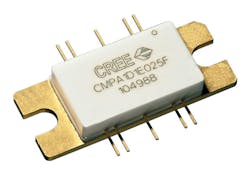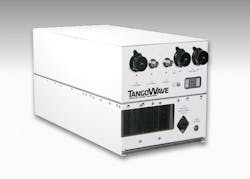This file type includes high resolution graphics and schematics when applicable.
The latest RF/microwave technology is enhancing performance for the satellite-communications (satcom) industry with a wide range of products. Among the products leading this charge are high-power gallium-nitride (GaN) devices, which are empowering the next generation of solid-state power amplifiers (SSPAs). Because GaN technology can achieve performance levels beyond previous-generation technology, SSPA manufacturers can develop their products with better performance in smaller sizes.
While GaN technology has certainly received a significant amount of attention, traveling-wave-tube (TWT) technology remains a vital aspect of the satcom industry. Ka-band is another major focus, as the usage of this frequency band has significantly increased in recent years. Many Ka-band products are on the market today, as manufacturers seek to support this frequency band. In addition, manufacturers of passive components are supporting the satcom industry with a wide range of products intended for satcom applications. By taking a closer look at these five areas, it is possible to track the near-term evolution of satcom and discover how RF/microwave technology is enabling the satcom industry.
1. Ka-Band Communications
Ka-band is the most recently utilized frequency band to be authorized for commercial satcom. In comparison to other satcom bands, such as Ku-band, Ka-band uses bandwidth more efficiently and is less congested. Thus, Ka-band has become a popular choice for satellite operators in recent years. Although there are some differences worldwide in regards to its exact frequency range, Ka-band is generally considered to span 17.3 to 31.0 GHz. A vast array of RF/microwave products intended for Ka-band satcom applications is available today.
Typical block upconverters (BUCs) used in satellite uplink transmissions convert a band of signals from the L-band frequency range to a higher frequency band, such as C-, Ku-, and Ka-band. The block downconverters (BDCs) that are typically used in satellite downlink transmissions perform the reverse function. They convert a band of signals from a frequency range, such as C-, Ku-, and Ka-band, down to the lower L-band frequency range.
With Ka-band communications becoming more prevalent, high-performance Ka-band BUCs and BDCs are needed to support these requirements. Among the companies offering Ka-band BUCs and BDCs are L3 Narda-MITEQ, GeoSync Microwave, Cross Technologies, Jersey Microwave, and WORK Microwave, to name a few. Some suppliers offer the option to purchase these BUCs/BDCs as either an outdoor unit intended for antenna-mounting or as an indoor unit intended for rack-mounting.
2. High-Power GaN Devices
Today, high-power GaN devices are being used to create the next-generation of GaN-based SSPAs. Prior to the advent of GaN technology, high-power gallium-arsenide (GaAs) devices were widely used to design SSPAs. Thanks to GaN technology’s continuous improvements, SSPA manufacturers are now building SSPAs with GaN devices. GaN technology offers a number of performance benefits in comparison to the older GaAs technology. A GaN device can deliver significantly more power density than a GaAs device. Thus, GaN-based SSPAs can be designed by power-combining fewer devices, resulting in greater efficiency. This also enables GaN-based SSPAs to be built in smaller package sizes than GaAs-based SSPAs. New high-power GaN devices have recently been released, providing additional high-power solutions to the satcom market.
With its portfolio of high-power GaN devices, Cree is one company enabling GaN technology to be utilized in satcom applications. The company recently added to its product line with the release of a new high-power monolithic microwave integrated circuit (MMIC) (Fig. 1). This GaN MMIC is a two-stage high-power amplifier (HPA) intended for Ku-band applications. It is available in a 10-lead, 25-×-9.9-mm, metal/ceramic flanged package (model CMPA1D1E025F) or as bare die (model CMPA1D1E030D).
“Cree’s new Ku-band GaN MMIC HPA was specifically designed in response to customer requests for higher-power and higher-efficiency Ku-band amplifier solutions,” said Tom Dekker, director of sales and marketing, Cree RF. “By delivering higher power, gain, and efficiency at an affordable price point, this amplifier will set the new standard for Ku-band performance.”
Dekker added, “Covering the 13.50-to-14.75-GHz commercial satcom band, the 30-W gallium-nitride-on-silicon-carbide (GaN-on-SiC) MMIC, two-stage high-power amplifier (HPA) enables the satcom industry to achieve higher-power and more efficient Ku-band solutions than the incumbent traveling-wave-tube (TWT) or GaAs solutions used currently. Applications include unmanned intelligence, surveillance, and reconnaissance (ISR), satcom-on-the-move (SOTM) ground vehicles, manned and unmanned aircraft, and maritime vessels.”
High-power GaN devices from Cree are also available for other satcom bands. An example is model CGHV96050F1, which is intended for X-band applications. Ka-band products are also currently being developed.
In addition, Qorvo recently released GaN power amplifiers (PAs) intended for commercial very-small-aperture-terminal (VSAT) and military satcom applications. Those PAs include the TGA2239-CP, TGA2595-CP, and TGA2594-HM. The TGA2239-CP is intended for Ku-band applications, while the TGA2595-CP and TGA2594-HM both target Ka-band applications. The TGA2239-CP provides 35 W output power from 13.4 to 15.5 GHz. The TGA-2595-CP is an 8-W PA covering 27.5 to 31.0 GHz, while the TGA2594-HM provides +36.5 dBm of output power from 27 to 31 GHz. These PAs add to the company’s existing portfolio of high-power GaN products.
For its part, Toshiba has a line of high-power GaN devices that are suitable for C-, X-, and Ku- band applications. A new Ka-band, high-power GaN MMIC is also scheduled to be released by the end of this year. This MMIC, the TGM2931-15, will provide 15 W output power from 29 to 31 GHz. The company also recently began production of the TGI5867-130LH, which is a C-band, 130-W GaN device.
3. Solid-State Power Amplifiers
With the number of high-power GaN devices available on the market, SSPA manufacturers can design their products using the latest GaN technology. Advantech Wireless, for example, has an extensive product line of GaN-based SSPAs. The company offers GaN-based products for C-, X-, DBS-, and Ku-band. As part of the company’s SapphireBlu series, C- and X-band SSPAs with output power levels as high as 6.6 kW are available as well as Ku-band SSPAs with output power levels as high as 3 kW.
One newcomer to the scene is Mission Microwave Technologies. Founded in 2014, the company offers SSPAs with integrated BUCs in a cylindrical package (Fig. 2). The company utilizes advanced GaN transistors, power-combining technology, and novel full-system designs to create compact SSPAs.
“The amplifiers in the new Javelin and Stinger product lines deliver more than 100 W and 55 W at Ku-band, respectively,” said Francis Auricchio, Mission Microwave Technologies’ president and CEO. “Unmatched prime power efficiencies of over 20% are achieved in lightweight, compact form factors that include upconverters, linearization, and integrated power supplies. Both the Stinger and the Javelin amplifiers include a standard user-friendly Bluetooth mobile app remote for monitor-and-control, which makes it simple for users to adjust power levels on the fly without a physical connection to the amplifier. Ruggedized for harsh outdoor environments, our Ku-band amplifiers are available now, with 50-W and 25-W Ka-band amplifiers following right behind.”
Explaining the innovative packaging of these SSPAs, Auricchio noted, “Our unique packaging was developed as we worked to realize the absolute minimum in amplifier size, weight, and volume, which is difficult to achieve by more traditional methods without sacrificing performance and reliability. Typical rectangular-shaped units tend to have heatsinking across the amplifier that is either uniform and underutilized or inefficient and unbalanced. Our cylindrical package optimizes the heatsinking to where it is needed most and provides airflow over the complete amplifier body. These aspects together maintain thermal performance—even in a small form factor. Satcom customers continue to request smaller and lighter units, especially for mobile and man portable applications. By optimizing the form factor of our products, we have been able to deliver this without sacrificing performance.”
A wide range of GaN-based SSPAs also is offered by Teledyne Paradise Datacom. Outdoor SSPAs are available for S-, C-, X-, and Ku-band with a wide range of output power levels. The company provides various packaging options for these SSPAs.
The Outdoor PowerMAX, Teledyne Paradise Datacom’s new high-power SSPA system, was recently unveiled. Its system architecture is a multi-module amplifier system, which allows PowerMAX systems to be configured with a large variety of output power levels. It also is a scalable amplifier system, as an Outdoor PowerMAX system may be initially configured with four modules and later upgraded to eight modules in the field. In addition, the system can grow with future power and bandwidth demands. The C- and X-band versions of the Outdoor PowerMAX system can generate an output power level as high as 10 kW, while the Ku-band version provides as much as 5.7 kW output power.
4. Traveling-Wave-Tube Amplifiers
With the excitement created by GaN technology, it may seem like traveling-wave-tube amplifiers (TWTAs) have been abandoned. However, TWTAs are still being used today. In fact, the technology has advanced in recent years. TWTA manufacturers continue to release new products, demonstrating that this technology is alive and well.
Yet the debate between SSPAs and TWTAs continues. Manufacturers of SSPAs like to point out the advantages that SSPAs have over TWTAs. The introduction of GaN technology has added fuel to the fire, as GaN-based SSPAs can provide performance improvements over previous-generation GaAs-based SSPAs. While SSPAs do have their benefits, TWTAs can still provide advantages over SSPAs in some applications. Thus, deciding on a preferred amplifier technology is dependent on the specific application.
One company providing TWTAs to the satcom market is Tango Wave. The company offers TWTAs for DBS-, Ku-, and Ka-band with output power levels as high as 1250 W (Fig. 3). Those products are designed for direct-to-home (DTH), global up-linking, satellite news gathering (DSNG/SNG), broadcasting, voice/data, mobile up-linking, and maritime applications.
For its part, Comtech Xicom Technology recently introduced the Ku- and DBS-band SuperPower Series TWTAs. These TWTAs are available in both frequency bands as either outdoor antenna-mount units or as indoor rack-mount units. The XTD-2000KHE model is a Ku-band TWTA that provides 750 W of linear output power while drawing less than 3200 W of prime power. The XTD-1500DBSHE model is a DBS-band TWTA that provides 560 W of linear power while drawing only 2500 W of prime power.
The SuperLinear TWTA product line from Communications & Power Industries (CPI) touts advantages in efficiency. These TWTAs range in efficiency from 13% for lower power models to over 22% for 2500-W amplifiers. The company offers SuperLinear TWTAs for X-, Ku-, and Ka-band.
LifeExtender is CPI’s new, patented technology, which is intended to increase a TWT’s lifespan. With the LifeExtender method, a TWT’s lifespan is extended by preserving the active coating on the cathode surface. A TWT reaches the end of its life when its cathode barium reserve is exhausted. The rate of barium evaporation is determined by the cathode temperature, which is in turn determined by the cathode heater voltage setting. With LifeExtender, the cathode heater voltage is adjusted over time to minimize the rate of barium depletion, thereby maximizing the life of the cathode. As a result, a TWT’s lifespan can increase by 30% to 50%.
5. Passive Components
Passive components are an integral part of any satcom system. These components include filters, couplers, isolators, and more. Many manufacturers offer a wide range of passive components for satcom applications.
For example, Advanced Technical Materials (ATM) offers an entire product line of components for Ka-band applications. These components cover the uplink frequency range of 27.5 to 31.0 GHz and the downlink frequency range of 18.3 to 20.2 GHz. The company offers both coaxial and waveguide models. The product line includes power dividers, attenuators, phase shifters, couplers, and more.
Another example of a company providing passive components to the satcom market is ETG Canada. The company’s SSPA original equipment manufacturer (OEM) product line is intended to allow SSPA OEMs to purchase waveguide components from the same vendor. This product line includes adapters, circulators/isolators, terminations, and couplers. The company’s TUBE HPA OEM product line includes many similar components intended for TWTA and klystron power amplifier (KPA) OEMs.
To summarize, a significant amount of activity is occurring in the RF/microwave industry in support of satcom applications. GaN technology is receiving a significant amount of attention, as it is enabling the next-generation of SSPAs. New high-power GaN devices will continue to be released in the near future. TWT technology also continues to be an important contributor to the satcom industry. And as Ka-band satellites continue to be implemented, suppliers are providing components to support this frequency band.
This file type includes high resolution graphics and schematics when applicable.




